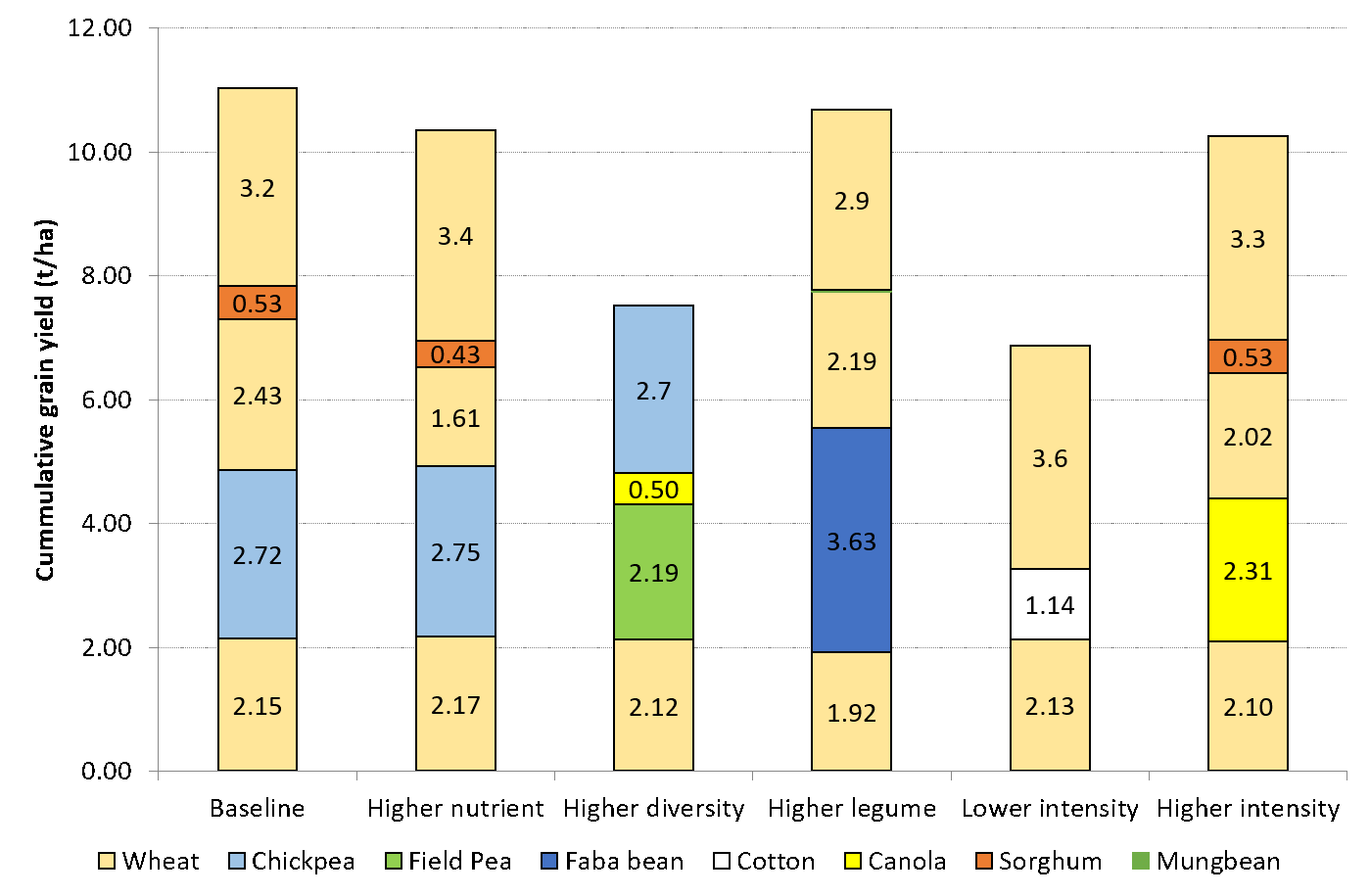Farming systems research update Narrabri
13 Dec 2021
Key Points
- Four out of six farming systems studied produced similar total grain production.
- Two systems, the baseline system (similar to the existing local farming system) and the high legume system produced the highest overall gross margin.
- The high nutrient system showed no advantage in terms of total yield indicating that moisture rather than fertility limited yield.
Since 2014, the Department of Primary Industries (NSW DPI) has been investigating the relative productivity of several different crop rotation systems at the University of Sydney’s farm “Llara”, near Narrabri. This work was part of a Farming Systems project funded by NSW DPI, QDAF, CSIRO and the GRDC and is aimed at addressing issues of long-term fertility decline and increasing soil pathogen and herbicide resistance issues.
The soil type at “Llara” is a chocolate vertosol with a PAWC of 210 mm to a depth of 120 cm, with high exchangeable sodium at depth which may limit moisture removal by crops.
Six different cropping systems were investigated. These include:
- Baseline - this system is based on local commercial cropping systems. Crops were planted when stored soil moisture was at least 50% of maximum PAWC. Over the trial period this consisted of wheat-chickpea-wheat-sorghum-wheat.
- Higher nutrient – same rotation as the Baseline system with higher nitrogen application to target greater yield (90% target yield) and additional phosphorus (P) to replace that removed by grain export.
- Higher crop intensity – Planting on a minimum 30% moisture profile and fertilised for an average yield. For the trial to-date, the sequence was wheat-canola-wheat- sorghum/double crop chickpea-wheat.
- Higher crop diversity – aims to grow a greater range of crops. Crops choice involves resistance to root lesion nematode and rotation of herbicide modes of action. Crops were planted on at least moderate soil moisture. In the trial to-date, the sequence was wheat-fieldpea-canola- durum-chickpea.
- Higher Legume – Aims at reducing nitrogen inputs and maintaining soil fertility, one in every two crops being a legume. For the trial the sequence was wheat-faba bean-wheat-mungbean-wheat.
- Lower intensity – higher value crops are targeted and planted when the moisture profile was greater than 80% full. For the trial the sequence to-date has been wheat-cotton/cover crop- long fallow-wheat.
All crops were established using a disc planter and full stubble retention was practiced. In-crop herbicides and insecticides were applied according to established industry thresholds and practice; however, no residual herbicides were used in the Higher intensity system.
Temperatures departed from the average with a higher-than-average number of days with maxima over 350C in 2016, 2017, 2018 and 2019 compared to the long-term average. These high temperatures effected the performance of summer crops. Due to the drought, there was little grain production during 2018–19.
Key findings
In analysing the results, the performance of the various systems was measured in two ways:
- Total tonnage of grain and lint produced by each system over the five years
- The total gross margin in terms of dollars per hectare over the trial period.
Average grain and cotton prices over a ten-year period minus grading and delivery costs were used to calculate income. Costs were calculated from inputs used in each trial system and prices quoted from one rural merchandiser in Toowoomba.
The Baseline, Higher nutrient, Higher legume and Higher intensity systems resulted in similar total grain production of 11.1, 10.6, 10.8 and 10.4 t/ha respectively over the trial period (Figure 1). The four systems (Baseline, Higher nutrient, Higher legume and Higher intensity) produced more grain and lint than both the Higher Diversity and Lower intensity systems (7.6 and 7 t/ha). The Higher diversity system experienced two crop failures, canola in 2017 from frost and durum in 2019 from moisture stress. Total production in the Lower intensity system suffered from the lack of crops (3) compared to the Baseline system (5).
In terms of grain yield, the Higher nutrient system provided no advantage as no crop between 2015 and 2020 outperformed the corresponding crop in the Baseline system. This result suggests that moisture rather than nutrition was the limiting factor to yield.

At Narrabri the baseline and higher legume system had the greatest accumulated gross margins of $1313/ha and $1324/ha. The baseline system had higher crop income and higher associated costs compared to the higher legume system. The higher legume system gave a higher return on variable costs compared to the baseline system, for example less fertiliser was applied in the higher legume system reducing crop costs.
The higher intensity and lower intensity cropping rotations had similar gross margins, $808/ha for the higher intensity and $858/ha for the lower intensity, both substantially less than the baseline and higher legume system.
The higher nutrient system also underperformed with a gross margin of $701/ha. This was due to higher fertiliser costs that produced no extra grain.
Three of the four systems that were in crop the longest (i.e., percentage of the project life that there was a crop in the ground) had higher fallow efficiency. These were the higher intensity, baseline and higher nutrient systems that had fallow efficiencies of 32%, 30% and 26% respectively. The higher legume system, which was in crop for an equally long period, had a lower fallow efficiency probably due to legume residues breaking down more quickly and leaving less ground cover.
For more information contact:
- Jon Baird M. 0429 136 581; E. jon.baird@dpi.nsw.gov.au
- Kathi Hertel M. 0427 104 344; E. kathi.hertel@dpi.nsw.gov.au